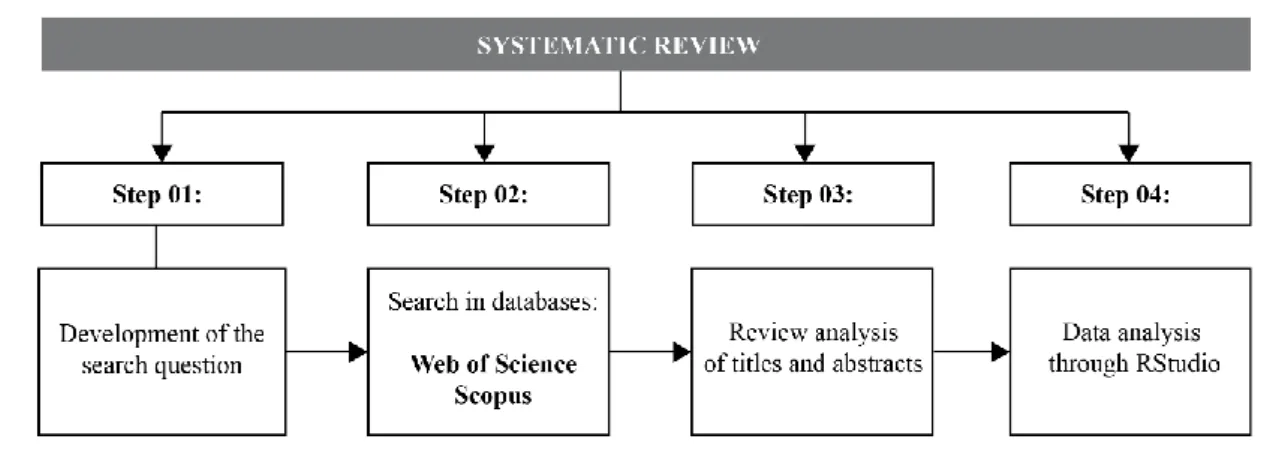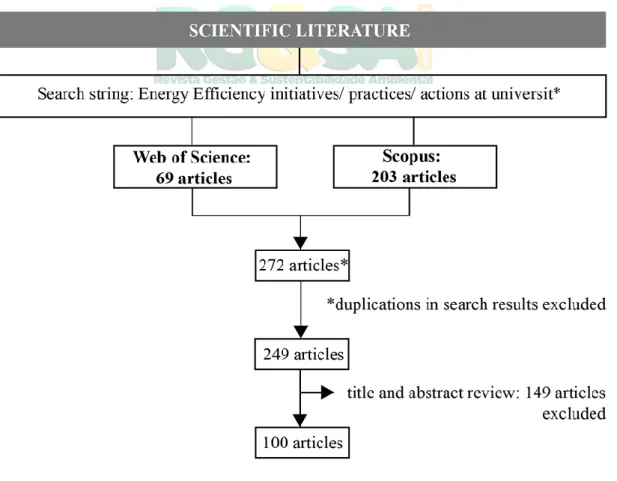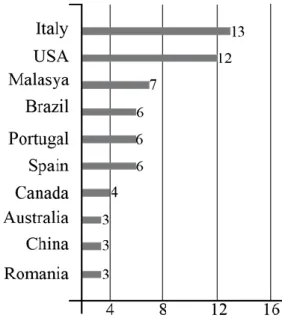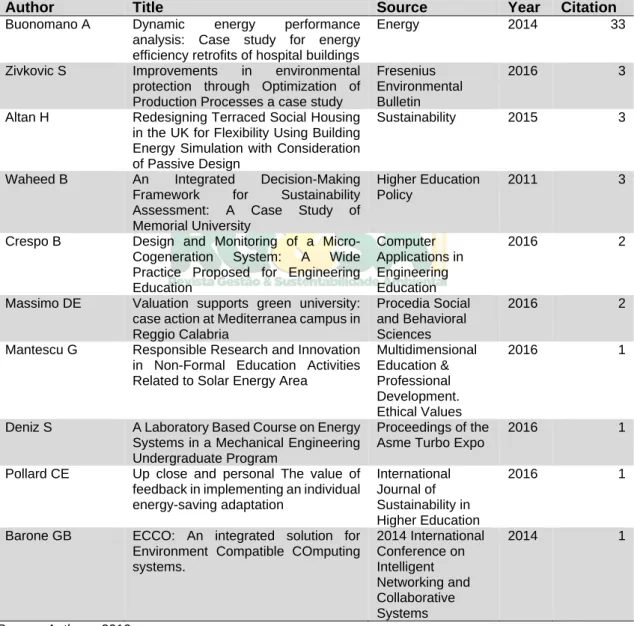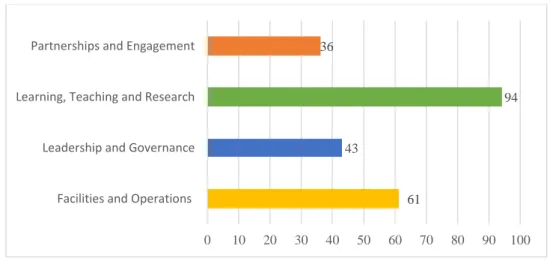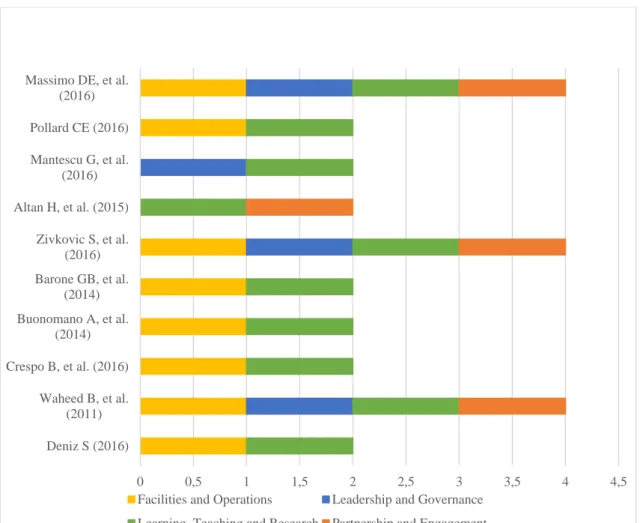ENERGY EFFICIENCY INITIATIVES AT UNIVERSITIES: A SYSTEMATIC LITERATURE REVIEW
DOI: 10.19177/rgsa.v9e0I2020503-524
Bianca Gasparetto Rebelatto1
Amanda Lange Salvia2
Giovana Reginatto3
Luciana Londero Branldi4
Marcos Antonio Leite Frandoloso5
ABSTRACT
Energy efficiency has received increasing attention in sustainable development over the past years due to the attention of climate change mitigation. In this context, universities have the role of promoting sustainability through energy efficiency efforts, improving environmental, economic and social aspects and increasing energy savings and the use of renewable energy. The aim of this paper is to perform a systematic review of the literature on the topic energy efficiency initiatives/practices/actions at Universities and analyse how they are contributing to the four categories created by LiFE Index: facilities and operations; leadership and governance; learning, teaching and research; partnerships and engagement. The databases Web of Science and Scopus were used to the review and resulted in 100 articles published in the last 10 years. This research
1 Graduate Program in Civil and Environmental Engineering. University of Passo Fundo.
biancagrebelatto@gmail.com
2 Graduate Program in Civil and Environmental Engineering. University of Passo Fundo.
amandasalvia@gmail.com
3 Graduate Program in Civil and Environmental Engineering. University of Passo Fundo.
gioreginato@gmail.com
4 Graduate Program in Civil and Environmental Engineering. University of Passo Fundo.
brandli@upf.br
5 Graduate Program in Civil and Environmental Engineering. University of Passo Fundo.
illustrates a comprehensive approach related to the panorama of initiatives, practices and actions that universities are developing in the energy efficiency topic. In addition, the literature review highlights examples and barriers between energy efficiency and sustainable development by comparing and analysing them, showing its relevant features.
Key words: Universities. Energy efficiency. Sustainable Development.
Systematic review. LiFe Index.
1 INTRODUCTION
Energy efficiency is an essential strategy in energy and climate change mitigation policies with several benefits that no only reduce greenhouse gas emissions and local air pollution, but indeed reduce investments in energy infrastructures, lower the needs for fossil fuel, and improve quality of life (TAYLOR et al., 2010). Since the energy production and utilization are responsible for 80% of carbon dioxide and two-thirds of total greenhouse gas emissions worldwide (INTERNATIONAL ENERGY AGENCY, 2015), energy saving is an important component of many national and international responses to climate change and fossil fuel depletion (COTTON et al., 2016).
Since universities can be compared to small towns due to their population size, infrastructure and environmental concerns such as footprints (ALSHUWAIKHAT and ABUBAKAR, 2008), as complex organizations, Bull et al. (2018) highlighted that they have a significant carbon footprint in their direct and indirect emissions. Regarding this context, universities have the role of promoting sustainability through energy efficiency efforts, improving environmental, economic and social aspects and increasing energy savings and the use of renewable energy. In addition, as presented in a recent systematic literature review on energy sustainability at universities (SALVIA and BRANDLI, 2020), research on energy efficiency is among the main areas that universities are exploring to contribute to sustainability goals. One way to promote Sustainable Development is education at higher levels as a way to improve the capacity to address environmental and developmental issues (AL-NAQBI and ALSHANNAG, 2018). In this learning way, through cognitive and affective domains, students can acquire knowledge, attitudes and behaviour regarding sustainability
(SHEPHARD, 2008). In addition, the increase of students’ enrolment in academic activities that involves sustainability is a critical component for knowledge economies and direct impacts on energy consumption with consequences in environmental, ethical and financial aspects (MTUTU and THONDHLANA, 2016).
In responses to climate change, energy efficiency has an increasingly important role to play (IPCC, 2014). As presented by Salvia and Schneider (2019), energy efficiency has become increasingly common, especially in the context of higher education, including actions to reduce energy waste, development of technologies, investment in more efficient buildings and in research centers.
Cotton et al. (2016) defend the idea that energy savings is critical for universities as carbon reduction levels, also sustainability in practice related to energy saving on campus is rarely integrated with teaching and learning and a wider student experience (WINTER and COTTON, 2012). In addition, Leal Filho et al. (2019) affirm that understanding the link between energy use and energy efficiency at universities can help to maximize the use of campus’ energy resources and reduction of carbon footprint.
The objective of this research was to identify through a systematic review of the literature energy efficiency initiatives/practices/actions at Universities and analyse how they are contributing to the four categories created by LiFE (Learning in Future Environments) Index: facilities and operations; leadership and governance; learning, teaching and research; partnerships and engagement, highlighting examples and barriers between energy efficiency and sustainable development by comparing and analysing them, showing its relevant features.
This paper is organized as 4 sections: the methodology is presented based on a systematic review and the studies of LiFE Index. Then, the results have also a discussion related to the 4 categories created by the measure instrument, and examples highlighted through the researches’ found.
2 METHODOLOGY
In this paper, to carry out the analysis of the best energy efficiency practices in universities, the authors conducted a systematic review that according to Denyer and Tranfield (2009) is a specific methodology that locates
existing studies, selects and evaluates contributions, analyses and synthesizes data, and describes evidence to allow clear conclusions about the subject. It differs from a literature review, since it represents a research that explores a specific issue with relevant criteria for selection/inclusion of articles (SALVIA and BRANDLI, 2020).
Therefore, in order to develop knowledge about the theme discussed, this study outlined the research question as: what are the practices/initiatives/actions of energy efficiency applied in the universities that are part of the literature and encompass worldwide what is being done by the Institutions of Higher Education? Two important databases were used to identify the most relevant publications in the specific topic, Scopus and Web of Science, because they have scientific publications in several relevant areas to the theme. In order to identify the articles on the websites, three search strings were used: "energy efficiency" practices at universit*, OR "energy efficiency" initiatives at universit*, OR “energy efficiency” actions at universit*, as described in Table 1.
Table 1: Research Topic for Performing Systematic Analysis
Research Topic:
"energy efficiency" practices at universit* (topic, abstract, title, keywords)
OR
"energy efficiency" initiatives at universit* (topic, abstract, title, keywords)
OR
energy efficiency" actions at universit* (topic, abstract, title, keywords)
Source: Authors, 2019.
The methodological process of the systematic review through stages is shown in Figure 1 and can be described as: development of the search question, search of the publications in the databases, application of review analysis of titles and abstracts, and data analysis through the software RStudio.
Figure 1: Steps Systematic Review
Source: Authors, 2019.
For the systematic search, the criteria used was the period, between the years 2010 to 2019, and the language - English, Spanish or Portuguese. All types of publications (journals, reviews, book, conferences) were included in the search, as well as all search areas, according to Table 2.
After the search, the publications were extracted to the Microsoft Excel software to verify the duplication. The content analysis to filter the publications, according to the study’s line of interest was through the analysis of the title and the abstract, as suggested by Schulze et al. 2016.
Table 2: Criteria for Research
Criteria Inclusion Exclusion
Period 2010 to 2019 Any publication before 2010 and
after May 2019.
Language English, Spanish,
Portuguese Any other language
Source: Authors, 2019.
To analyse and synthesize the data, RStudio interface was used. It’s an extension of R software that uses a statistical programming language, available for free download (www.studio.com). This software provides a wide statistical variety (linear and non-linear modeling, classical statistical tests, time series analysis, classification, grouping, among others) and graphic techniques (R-PROJECT, 2019).
The remaining articles were analysed according to the categories used by Macgregor (2015) on James Cook University, located in Australia. The categories are: Leadership and Governance, Partnerships and Engagement, Learning,
Teaching and Research, Facilities and Operations. These are part of the LiFE Index - Learning in Future Environments - a system developed by the Environmental Association of Colleges and Universities of Australia, which can be defined as a performance improvement tool to help higher education institutions manage, measure, and improve their performance in social and environmental responsibility.
One of the defining characteristics of the LiFE Index is the flexible development and improvement frameworks, presented in four priority areas. These priority areas have been developed with a holistic approach in mind, to accurately reflect the core business of educational institutions and demonstrate key areas of focus for those who are already working with sustainability. Within each of the priority areas, there are a number of comprehensive frameworks that help analyse the institution's current sustainability activities, guide future strategic plans and encourage progress, in a simple, systematic, and proactive way (LiFE INDEX, 2019).
Table 3: Categories LiFE Index
Category Examples of selection criteria
Leadership and Governance (LG)
Higher Education Institution’s commitment with support and financial activities and initiates regarding sustainability
Partnerships and Engagement (PE)
Symposiums, conferences, projects in partnership with other universities, initiatives with partnerships of private companies
Learning, Teaching & Research (LTR)
Curriculum with focus on sustainability, course,
extension project, internship programs, extracurricular educational activities, research centers, etc.
Facilities and Operations (FO)
campus infrastructure, use of sustainable
technologies, separation of waste, energy efficiency, buildings, etc.
Source: adapted from Macgregor C, (2015).
As shown in Table 2, the Leadership and Governance category is based on the institution's commitment to support and finance activities and initiatives in relation to sustainability. In the second category, Partnerships and Engagement, symposiums, conferences, projects in partnership with other universities, and initiatives with partnerships of private companies are included. Learning, Teaching and Research includes up-to-date curriculum with focus on
sustainability, being it subject, course, extension project, internship programs, extracurricular educational activities, research centers, etc. For the last category, Facilities and Operations, the campus infrastructure is considered, using sustainable technologies, separation of waste, energy efficiency, buildings, among others (MACGREGOR, 2015).
3 RESULTS AND DISCUSSION
The analysis of the scientific literature with the search topic is shown in Figure 2. The total number of articles located in the databases numbered 272 (69 from Web of Science and 203 from Scopus). After the exclusion of duplications and content analysis (title and abstract), 100 articles were considered for the bibliometric analysis.
Figure 2: Mapping systematic article search
The bibliometric review was used to analyse the characteristics of publications in the topic of energy efficiency initiatives in universities, including countries, institutions, journals, citations, authors, content analysis (cloud of words most frequent in abstracts, author / title relations).
Figure 3 shows the proportion of articles published per year between the period of 2010 and May 2019. With this analysis, it is possible to notice that the number of publications follows a pattern of articles ranging from 10 to 14 per year, between 2013 and 2017. However, in 2018, the number of duplications almost double. That may be explained by the publication of Towards Green Campus Operations: energy, climate, and sustainable development initiatives at universities (LEAL FILHO et al., 2018), and also by other three events that occurred in the same year: IEEE ANDESCON Conference Proceedings, the IEE International Conference on automation, and the International Conference the Smart Energy Systems and Technologies, illustrating the relevance of the topic in the current context.
The systematic analysis included all categories of publications, finding the largest number of publications in conferences, followed by articles, book chapters, and review articles.
In relation to the first 10 sources of publication, the journal Sustainability has the largest number of articles (n=4). Followed by 3 articles published in the Journal of Cleaner Production and 3 publications in the Towards Green Campus Operations series - Energy, climate and sustainable development initiatives at universities. The journals with 2 publications each are: Energy, Advanced Materials and Research and Energy for Sustainable Development. The other sources of publication are the conferences: 2018 IEEE Andescon, World Energy Engineering Congress 2013, International Scientific Symposium of the Croatian Economy, and International Conference on intelligent networking and collaborative systems, as shown in Figure 3.
Figure 3: Number of publications in the last 10 years
Source: Authors, 2019.
Figure 4: 10 Most Published Sources
Source: Authors, 2019.
Figure 4 shows the distribution of the first 10 countries with the highest scientific production, according to the reference country of the main author of the publications. Italy is the leader with 13 articles published, followed by the United States with one less article. The number of publications per country declined considerably, resulting in 7 publications from Malaysia and 6 publications from Brazil, Portugal, Spain and Canada. Australia, China and Romania have 3 publications each.
Figure 5: Countries with the most publications
Source: Authors, 2019.
Regarding the first 10 most relevant authors to the publications in the researched topic, Table 4 describes the authors that the software R considered as most relevant - all of them have 2 publications.
Table 4: Most relevant authors
Authors Publications Aleixo J 2 Alves L 2 Guedes MC 2 Benitez DS 2 Borges K 2 Brandli LL 2 Danelli RC 2 Pereira I 2 Reginatto G 2 Villacreses S 2 Source: Authors, 2019.
The analysis of the abstracts and titles was developed by RStudio software. The word cloud, illustrated in Figure 6, shows that the words most found in the abstracts were energy, building, university, efficiency, sustainable, campus, consumption, performance, among others.
Figure 6: Word Cloud with the abstracts
Source: RStudio, 2019.
Figure 7: Network of co-occurring titles
The titles were analysed through Network analysis of co-occurrence, emphasizing the connections between the main word Energy with intermediaries, like university, that connects with buildings or campus, and in this way is forming Figure 7. The different colours are grouped as the connection and similarity of title’s topics, including a normalization of association and described as a Walktrap type of Clustering Algorithm, according to the software analysis R-Studio.
According to RStudio software analysis, the most cited articles are described in Table 5.
Table 5: 10 publications with the highest number of citations
Author Title Source Year Citation
Buonomano A Dynamic energy performance
analysis: Case study for energy efficiency retrofits of hospital buildings
Energy 2014 33
Zivkovic S Improvements in environmental
protection through Optimization of Production Processes a case study
Fresenius Environmental Bulletin
2016 3
Altan H Redesigning Terraced Social Housing
in the UK for Flexibility Using Building Energy Simulation with Consideration of Passive Design
Sustainability 2015 3
Waheed B An Integrated Decision-Making
Framework for Sustainability Assessment: A Case Study of Memorial University
Higher Education Policy
2011 3
Crespo B Design and Monitoring of a Micro-Cogeneration System: A Wide Practice Proposed for Engineering Education Computer Applications in Engineering Education 2016 2
Massimo DE Valuation supports green university: case action at Mediterranea campus in Reggio Calabria
Procedia Social and Behavioral Sciences
2016 2
Mantescu G Responsible Research and Innovation in Non-Formal Education Activities Related to Solar Energy Area
Multidimensional Education & Professional Development. Ethical Values 2016 1
Deniz S A Laboratory Based Course on Energy
Systems in a Mechanical Engineering Undergraduate Program
Proceedings of the Asme Turbo Expo
2016 1
Pollard CE Up close and personal The value of feedback in implementing an individual energy-saving adaptation International Journal of Sustainability in Higher Education 2016 1
Barone GB ECCO: An integrated solution for Environment Compatible COmputing systems. 2014 International Conference on Intelligent Networking and Collaborative Systems 2014 1 Source: Authors, 2019.
The 100 articles found were analysed according to the categories: Leadership and Governance, Partnerships and Engagement, Learning, Teaching
and Research, Facilities and Operations, are part of the LiFE Index - Learning in Future Environments (MACGREGOR, 2015).
Table 6 shows the number of articles that scored in 1, 2, 3 or 4 categories. It is noticed that 41% of the articles scored in two categories, reiterating the importance of connecting the energy efficiency initiatives with other areas beyond the research.
Table 6: Number of articles in 1,2,3 or 4 categories
4 categories 9 articles 3 categories 33 articles 2 categories 41 articles 1 category 17 articles Source: Authors, 2019.
When analysing the 100 articles by the title and abstract, it was punctuated with the number 1 the articles that had relation with the categories, and with the number 0 the articles that had no relation. Figure 8 shows that the category with the highest score was Learning, Teaching and Research (LTR), with a total of 94 points. Followed by Facilities and Operations (FO) category with 61 points, Leadership and Governance (LG) with 43 points and Partnerships and Engagement (PE) 36 points. In relation to the last two, it is noticed that the number of Partnerships and Engagement is as relevant as that of Leadership and Governance, demonstrating how important it is for Universities to seek external contributions from industries, companies, and other universities to improve their initiatives in relation to sustainability.
Figure 8: Articles punctuations’ in the four categories
Source: Authors, 2019. 61 43 94 36 0 10 20 30 40 50 60 70 80 90 100
Facilities and Operations Leadership and Governance Learning, Teaching and Research Partnerships and Engagement
Although most universities punctuated more in Learning, Teaching and Research, it is important to connect integrating practice and theory, as Leal Filho et al. (2018) suggested as through lighting in-service learning to promote teaching staff and inter alia student-engagement by synergetic action and ethical discussions. Tang (2018) defends that education for sustainable development aims to change the attitudes and behaviours of the future generations with concerted effort of educational and institutions and educators. In fact, the author’s study concluded that in the end of a course named Engineering Sustainable Development, the results of a questionnaire were positive impacts on the beliefs, attitudes and intentions of students’ who participated, showing the importance of how knowledge can contribute to sustainability. Other authors related to the systematic review discussed the needs of the engineering education about the energy efficiency, and the importance of involving the students and the academic community at the procedure development (CRESPO et al., 2016; DENIZ, 2016).
Regarding the category Leadership and Governance, Leal Filho et al. (2019) affirm that the implementation and adoption of sustainable procurement policies by Higher Education Institutions is a way to offer not only opportunities to reduce environmental issues and social impacts of their business operations, but also may contribute do raise awareness and commitment among staff and students. Furthermore, the support of senior management within a university is essential for bottom-up sustainable initiatives not fail in longer term due to a lack of investment and administrative support (ÁVILA et al., 2017). Waheed et al. (2011) also said that it is important to have a good communication and to develop a methodologically well-structured framework for decision-makers, to achieve sustainability activities’ goals at the university.
A Green Campus includes technologies, programs and even curricula courses related to sustainable development. Leal Filho (2018) defends the idea that some universities engage less on campus greening and more on research or teaching, as the results of this study shows. The author also affirms that to have green campus can be costly due to requirement of substantial investments and improvements in infrastructure, and that the campus greening programs need to be considered as part of a major, institutional approach towards environmental conservation and resources efficiency. With regard to the category
Facilities and Operations, the systematic review’s articles say that for universities to improve energy efficiency and to become a green campus, it must build a strategic plan for sustainability, through an intervention at the buildings’ architecture, using the natural resources as ways to the ventilation and insulation (MASSIMO et al., 2016). In addition, Barone et al. (2014) presented the implementation of a complex and smart system, which can automatically and dynamically control the use of energy, in order to reduce the consumption and consequently the energy costs.
Furthermore, Buonomano et al. (2014) describe the importance of the energy efficiency at the universities’ buildings, highlighting that the consumption will not only reduce with the consumers’ behaviours, although it is an important variable to consider, but also the building should be efficient energetically to consume less energy. Altan et al. (2015) show how to reinforce the energy efficiency by using a building energy simulation, regarding the local climate, in order to provide a sustainable building, which consume less energy. Mantescu et al. (2016) describe the importance of renewable energy, like solar energy, to increase energy efficiency in the university, and also to raise awareness among the academic community, as a way to improve the sustainable behaviour. Still in sustainability behaviour, Pollard (2016), describes a data system to monitoring the energy system, with the purpose of reduce the costs by energy-saving, in addition to encourage positively the academic community’s behaviour to save energy and be more sustainable.
Figure 9 shows the relation of the 10 most cited articles with the four categories analysed by LiFE. Only 3 articles scored in all categories. All articles ranked in the category Learning, Teaching and Research. 5 articles were rated in this category and more Facilities and Operations, 1 article scored the same and in Leadership and Governance, and 1 article rated in Learning, Teaching and Research, and Partnerships and Engagement.
Although Joshi et al. (2019) say that there are three division of barriers, which impede the development of the energy efficiency, being them: barriers of organizational, economic and behavioural, Ávila et al. (2017) affirm that the implementation of energy efficiency at university can cause positive impacts to the university’s structure, regarding the three main pillars of the sustainability. In fact, for Leal Filho et al. (2018) to approach the whole university embedding
sustainability can be recommended as tools for transformation in learning and education using teaching and learning, research, community engagement and general campus operations.
Figure 9: 10 most cited articles in the four categories
Source: Authors, 2019.
At the conclusion of this analysis, it is evident the connections between one or more energy efficiency categories of university initiatives, following the suggestion of Velazquez et al. (2006), that a higher education institution can be considered as a whole or as a part, which deals with and promotes, at regional or global level, the minimization of environmental, economic and social impacts in order to fulfil its functions of teaching, research, outreach and partnership, and management to help society make the transition to more sustainable lifestyles.
4 CONCLUSION
This research aimed at identifying energy efficiency practices at universities through a systematic literature review and analysing their contribution to the four categories used by the LiFE Index. After the search in the databases Web of Science and Scopus, 100 articles were considered for this study.
0 0,5 1 1,5 2 2,5 3 3,5 4 4,5 Deniz S (2016) Waheed B, et al. (2011) Crespo B, et al. (2016) Buonomano A, et al. (2014) Barone GB, et al. (2014) Zivkovic S, et al. (2016) Altan H, et al. (2015) Mantescu G, et al. (2016) Pollard CE (2016) Massimo DE, et al.
(2016)
Facilities and Operations Leadership and Governance Learning, Teaching and Research Partnership and Engagement
Results from the bibliometric analysis confirmed the expected trend of an increased number of publications in the last years. Not only did the topic of energy sustainability became more popular but also universities are more aware of their role in this context. By analysing title and abstracts, the main topics related to energy efficiency which arise were sustainable campus, buildings, renewable energy, energy consumption and education. It demonstrates how interconnected energy efficiency is in relation to other areas of sustainable campuses and the importance of education in raising awareness and promoting behaviour change. The results from the analysis according to the LiFE Index support this connection, since most articles were classified as examples of actions for Learning, Teaching and Research and Facilities and Operations. Less has been published in relation to Leadership and Governance and Partnerships and Engagement, which are areas that may need more attention and further investigation.
The contribution of this paper is twofold: it presented an overview of publications in the topic of energy efficiency, suggesting the most common sources, topics and authors of this area; and, by focusing in the classification per priority areas, it offered an analysis of how the published articles are related to the aspects of sustainability in universities, revealing areas that could receive more attention in order to improve the contribution of these educational institutions to energy efficiency.
Some limitations of this study include the aspects analysed in the review and the databases used. Future research may expand the analysis to other databases and add a full-text content analysis in order to investigate more aspects of each article, such as the methodology used in each one.
REFERÊNCIAS
AL-NAQBI, Ali Khalfan; ALSHANNAG, Qasim. The status of education for sustainable development and sustainability knowledge, attitudes, and behaviors of UAE University students. International Journal of Sustainability in Higher
Education, 2018.https://doi.org/10.1108/IJSHE-06-2017-0091
ALTAN, H.; GASPERINI, N.; MOSHAVER, S.; FRATTARI, A., 2015. Redesigning terraced social housing in the UK for flexibility using building energy simulation with consideration of passive design. Sustainability, v. 7, n. 5, p. 5488-5507. ALSHUWAIKHAT, H. M.; ABUBAKAR, I., 2015. An integrated approach to achieving campus sustainability: assessment of the current campus environmental management practices. Journal of Cleaner Production, v. 16, n. 16, p. 1777-1785, 2008.
ÁVILA, L. V.; LEAL FILHO, W.; BRANDLI, L., MACGREGOR, C. J.; MOLTHAN-HILL, P.; ÖZUYAR, P. G.; MOREIRA, R. M., 2017. Barriers to innovation and sustainability at universities around the world. Journal of Cleaner Production, v. 164, p. 1268-1278. doi: 10.1016/j.jclepro.2017.07.025
BARONE, G. B.; BOCCIA, V.; BOTTALICO, D.; CARRACCIUOLO, L. ECCO: An integrated solution for environment compatible computing systems. In:
International Conference on Intelligent Networking and Collaborative Systems, 2014, p. 545-550. IEEE.
BULL, R.; ROMANOWICZ, J.; JENNINGS, N.; LASKARI, M.; STUART, G.; EVERITT, D., 2018. Competing priorities: lessons in engaging students to achieve energy savings in universities. International Journal of Sustainability
in Higher Education, v. 19, n. 7, p. 1220-1238.
https://doi.org/10.1108/IJSHE-09-2017-0157
BUONOMANO, A.; CALISE, F.; FERRUZZI, G.; PALOMBO, A., 2014. Dynamic energy performance analysis: Case study for energy efficiency retrofits of hospital buildings. Energy, v. 78, p. 555-572.
COTTON, D.; SHIEL, C.; PAÇO, A., 2016. Energy saving on campus: a comparison of students' attitudes and reported behaviours in the UK and Portugal. Journal of Cleaner Production, v. 129, p. 586-595. http://dx.doi.org/10.1016/j.jclepro.2016.03.136.
CRESPO, B.; REY, G.; MÍGUEZ, C.; MÍGUEZ, J. L.; CUEVAS ALONSO, M., 2016. Design and monitoring of a micro‐cogeneration system: A wide practice proposed for engineering education. Computer Applications in Engineering
DENIZ, S. A Laboratory Based Course on Energy Systems in Mechanical Engineering Undergraduate Program. In: ASME Turbo Expo 2016:
Turbomachinery Technical Conference and Exposition, 2016, p.
V006T07A002-V006T07A002. American Society of Mechanical Engineers.
DENYER, D.; TRANFIELD, D., 2009. “Producing a Systematic Review”. In Buchanan; D. and Bryman, A., Eds., The Sage Handbook of Organizational
Research Methods, Sage, London, p. 671–689.
IEA, 2015. International Energy Agency. CO2 Emissions from Fuel Combustion.
IPCC, 2014. Summary for policymakers. In: Edenhofer, O., et al. (Eds.), Climate
Change 2014: Mitigation of Climate Change. Contribution of Working Group III
to the Fifth Assessment Report of the Intergovernmental Panel on Climate Change. Cambridge University Press, Cambridge, United Kingdom and New York, NY, USA.
JOSHI, G. Y.; SHEOREY, P. A.; GANDHI, A. V., 2019. Analyzing the barriers to purchase intentions of energy efficient appliances from consumer perspective.
Benchmarking: An International Journal.
LEAL FILHO, W., 2018. Greening University Campuses: Future Trends. In
Towards Green Campus Operations, p. 903-909. Springer, Cham.
https://doi.org/10.1007/978-3-319-76885-4_59.
LEAL FILHO, W.; FRANKENBERGER, F.; IGLECIAS, P.; MÜLFARTH, R. C. K., 2018. (Eds.). Towards Green Campus Operations: Energy, Climate and
Sustainable Development Initiatives at Universities. Springer.
LEAL FILHO, W.; RAATH, S.; LAZZARINI, B.; VARGAS, V. R.; DE SOUZA, L.; ANHOLON, R.; ... ORLOVIC, V. L., 2018. The role of transformation in learning and education for sustainability. Journal of Cleaner Production, v. 199, p. 286-295.
LEAL FILHO, W.; SKOULOUDIS, A.; BRANDLI, L. L.; SALVIA, A. L.; AVILA, L. V.; RAYMAN-BACCHUS, L., 2019. Sustainability and procurement practices in higher education institutions: Barriers and drivers. Journal of Cleaner
Production, v. 231, p. 1267-1280.
Learning in Future Environments, 2019. Welcome to LiFE,
MACGREGOR, C. J., 2015. James Cook University’s holistic response to the sustainable development challenge. In Transformative Approaches to
Sustainable Development at Universities, p. 25-40. Springer, Cham. DOI
10.1007/978-3-319-08837-2_3.
MANTESCU, G.; GORGHIU, G.; STATE, G., 2016. Responsible Research and Innovation in Non-Formal Education Activities Related to Solar Energy Area. In
7th LUMEN International Scientific Conference on Multidimensional Education and Professional Development. Ethical Values (MEPDEV).
Targoviste, Romania.
MASSIMO, D. E.; FRAGOMENI, C.; MALERBA, A.; MUSOLINO, M., 2016. Valuation supports green university: case action at Mediterranea campus in Reggio Calabria. Procedia-Social and Behavioral Sciences, v. 223, p. 17-24.
MTUTU, P.; THONDHLANA, G., 2016. Encouraging pro-environmental behaviour: Energy use and recycling at Rhodes University, South Africa. Habitat
International, v. 53, p. 142-150.
POLLARD, C. E., 2016. Up close and personal: The value of feedback in implementing an individual energy-saving adaptation. International Journal of
Sustainability in Higher Education, v. 17, n. 1, p. 68-85.
R-PROJECT (2019). The R Project for Statistical Computing, https://www.r-project.org/. (last accessed 5/5/2019).
SALVIA, A.L,; BRANDLI, L.L., 2020. Energy Sustainability at Universities and Its Contribution to SDG 7: A Systematic Literature Review. In: Leal Filho W. et al. (eds) Universities as Living Labs for Sustainable Development. World Sustainability Series. Springer, Cham, p. 29-45.
SALVIA, A.L.; SCHNEIDER, L.L., 2019. Overall Energy Efficiency and Sustainable Development. In: Leal Filho W. (eds) Encyclopedia of
Sustainability in Higher Education. Springer, Cham.
SHEPHARD, K., 2008. Higher education for sustainability: seeking affective learning outcomes. International journal of sustainability in Higher
Education, v. 9, n. 1, p. 87-98.
TAYLOR, P. G.; D’ORTIGUE, O. L.; FRANCOEUR, M., TRUDEAU, N., 2010. Final energy use in IEA countries: The role of energy efficiency. Energy Policy, v. 38, n. 11, p. 6463-6474.
VELAZQUEZ, L.; MUNGUIA, N.; PLATT, A.; TADDEI, J., 2006. Sustainable university: what can be the matter? Journal of Cleaner Production, v. 14, n. 9-11, p. 810-819.
WAHEED, B.; KHAN, F.; VEITCH, B.; HAWBOLDT, K., 2011. An integrated decision-making framework for sustainability assessment: a case study of Memorial University. Higher Education Policy, v. 24, n. 4, p. 481-498.
WINTER, J.; COTTON, D., 2012. Making the hidden curriculum visible: sustainability literacy in higher education. Environmental Education Research, v. 18, n. 6, p. 783-796.
ZIVKOVIC, S.; TODOROVIC, M.; PEJCIC, D., 2016. IMPROVEMENTS IN
ENVIRONMENTAL PROTECTION THROUGH OPTIMIZATION OF
PRODUCTION PROCESSES A CASE STUDY. FEB-FRESENIUS
